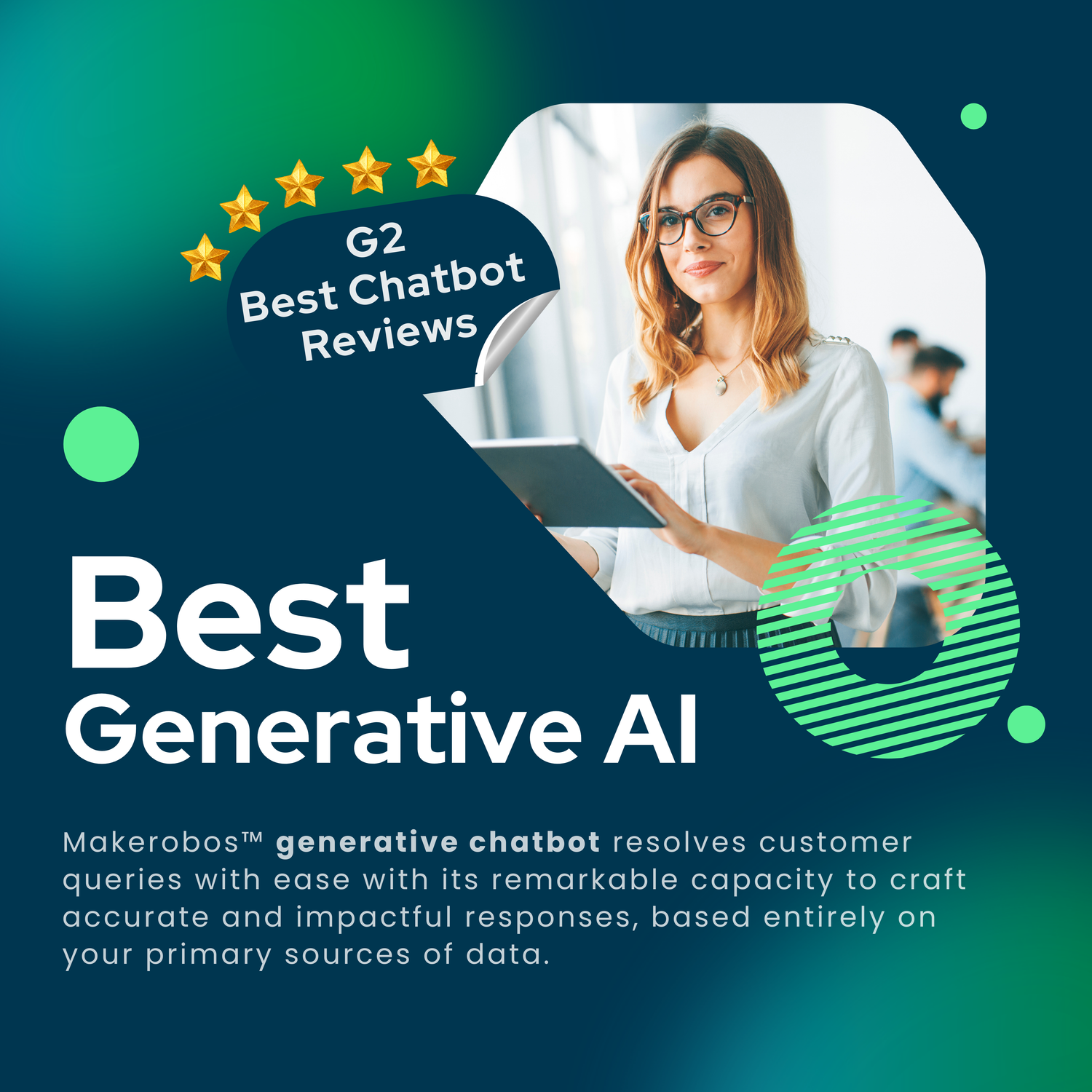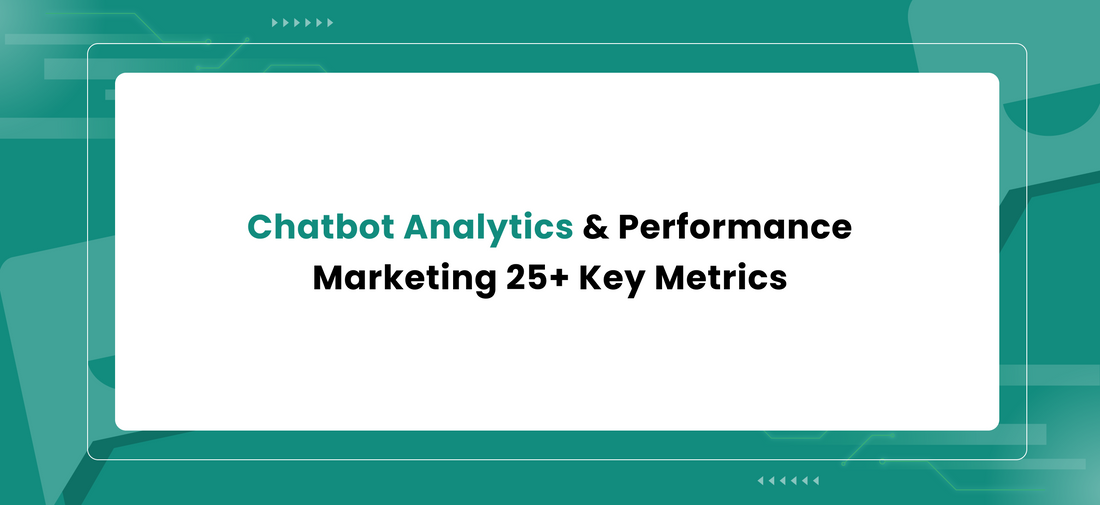Undoubtedly, integrating a chatbot into your marketing campaign can make your interaction with the buyers more dynamic. Also, a single bot can assist your customers by answering their product-related queries even when human assistance is not available.
Related must-reads:
The Rise of Chatbots and Their Role in the Future of Business
Best AI Chatbots of 2024 : A Comprehensive Guide to the Top Platforms
Even though chatbots have become the talk of the town and play a crucial role in the world of marketing, many marketers are not well-versed about the critical chatbot metrics, such as the number of visits, number of product visits, average session duration, current page visit, etc.
Hence, as a result, marketers often get stuck with how to analyze and improve chatbot performance.
To help you cope with these issues, we have made a list of 25 key metrics that you should know. These will help in measuring and optimizing your chatbot's performance to ensure that it provides the best user experience. But before we begin, lets first understand what chatbot metrics are?
What are the Chatbot Performance Metrics?
Chatbot metrics explain the capabilities of a bot implemented in a specific business process. By defining the right parameters, you can keep an eye on the chatbot’s performance w.r.t efficiency, responses, and completion of business goals.
Types of Chatot Metrics
- User Metrics
- Conversation Metrics
- Chatbot-specific Metrics
- Business Metrics
User Metrics that you should know about:
User metrics include parameters that mainly rely on your end-users. Here’s a list of such factors that need to be checked in order to analyze the performance of your business chatbot.
1. Interaction Count or Total Reach
Getting a higher reach should be the topmost priority for every chatbot marketing campaign. In simpler words, the higher your reach, the better your campaign will do. The interaction count combines the reach of both new and repeated visitors.
In addition, to boost marketing campaigns' reach, you can employ Conversational Ads. When compared to traditional tools of marketing, the latter one proves to be effective and cost-efficient.
While running Conversational Ads, when a user clicks on the ad URL, a chat-based landing page pop-ups. With chatbot on the other end, it becomes viable for buyers to ask their queries and learn about the product. Hence, it gives you a higher reach and interaction time.
2. Active Users
The total number of users who read bot’s messages are counted as active users. Such users can be termed as potential buyers. Hence while running a promotional campaign, tracking the number of active users is important.
3. Engaged Users
These users are defined as the ones that converse with the bot. Such users play a vital role in explaining the performance of chatbot. Because based on their interaction, you’ll need to refine the bot’s performance accordingly.
4. New Users
It’s essential to know the reach of chatbot’s campaigns to new users. This will help in learning about user preferences, so you can better tailor your marketing strategy. Also, by engaging with new users, you can grow customer base effectively.
5. User Average Interaction Duration
It is one of the essential metrics for Chatbot Optimization. After you examine that your c+hatbot interacts with a sufficient number of users, your second target should be to monitor the Average Interaction Duration of every user. You will need to count and measure every stats that can provide a basic idea of its usage.
For example, if you have implemented your chatbot for assisting visitors on queries only. Then the average interaction duration would be shorter. Contrary to this, when applied for multiple functions such as booking appointments, paying bills, or placing orders. Then the Average Interaction Duration should be accordingly high.
6. Session And Interaction Per User
On average, almost 40% of users who interact with chatbot don't find it helpful and quits the chat window. Looking deeper into these stats suggest that many times chatbot couldn’t provide the relevant answer to the user queries.
You can check the conversational flows from where users have quitted earliest. And with this analysis, you can optimize your chatbot for better customer assistance. Moreover, chatbot’s performance needs to be monitored based on interaction per individual user.
7. Active But Not Engaged Users
Not every visitor who visits your website needs to prefer using a chatbot to get assistance or perform any other specific function. Those users who don’t get engaged with a chatbot even after being active are analyzed in this metric. You can optimize your chatbot to show contextual attractive broadcast messages that can grab the attention of those unengaged active users.
8. User sentiments:
It explains users' sentiments and consequent actions upon seeing a particular message, like if a user has continued the conversation or left in between. Such messages can be marked as positive, neutral, and negative. This can help you improve the presentation of messages and better understand chatbot’s user experience.
Conversation Metrics that you should know:
Conversation metrics give you insight into the individual’s interaction with the chatbot. Let’s learn about them in brief:
9. Length of Conversational Flow
This metric defines one of the essential factors of chatbot performance. Marketers often fail to analyze it correctly and end up facing the poor performance of marketing campaigns. The primary purpose of a chatbot is to minimize the customer's efforts in getting assistance on their query and make tasks l like an appointment booking, product ordering, purchasing a service, etc. quicker than other methods.
But unnecessary dialogues in the conversational flow can make the concept of chatbot less meaningful. Updating the conversational flow regularly to make it simpler, shorter, and more engaging can optimize it to deliver better performance.
10. Welcome Messages
Welcome messages pave the path for the very beginning of communication between chatbot and customers. They should be designed by keeping in mind the requirements of website visitors. By analyzing the welcome messages, you can enhance the effectiveness of chatbot conversations with potential customers.
11. Total Chatbot Messages
These are the number of messages sent to a single user via chatbot. It’s useful in understanding how long a chatbot can fulfill user requirements. The higher the number of messages sent to individual users explains the business reach. However, you should thoroughly train the chatbot, as in the case of unanswered queries, the chatbot will repeat the same message.
12. Messages Sent by Users
In order to understand whether users are engaging with chatbot or not, you should track the number of messages sent by them. These numbers should be high; otherwise, the motive behind deploying chatbot will be worthless.
13. Unanswered User Messages
This metric explains the inefficiency of chatbot while answering the specific queries of users. When the number of unanswered queries is high, it means users are not getting the expected solution for their problem. Therefore, you should keep track of such queries and train chatbot with the same. So, when in the future, any user repeats the same query, it gets answered immediately.
14. Completed Conversations
While tracking the performance of marketing campaigns via chatbot, it’s essential to understand how many users have successfully initiated and completed the journey. By comparing the completed conversation with the total number of initiated, you can learn about the effectiveness of campaigns.
15. New Conversations
It includes the conversations started by both new and returning users. The total number of new conversations defines the adaptability of users for getting assistance via chatbot.
Chatbot-Specific Metrics that you should know:
After understanding about the chatbot’s performance in terms of user interaction and conversations, let’s learn about the chatbot-specific metrics:
16. Reaction of Chatbot When It Fails To Answer
You can’t make your chatbot as smart as human assistants. Maybe in the future, we could achieve 100% accuracy. But, as of today, there could be many times when a chatbot can fail to answer complex queries.
You can use quotes such as “Umm… I don’t understand your query, can you say it differently?”
You can also analyze every conversational flow that chatbot couldn’t be able to answer. And optimize the bot by training it on such queries.
17. Chatbot Response time
Offering a human experience to the buyers requires a reasonable balancing between instant response and typing delays within replies. Giving replies quickly to users makes them feel like a bot is answering their queries. However, adding typing delays in-between the conversational flows can make users feel like they are conversing with a human representative. These metrics mostly need to be monitored when chatbot has to give a lengthy reply or while it provides a suggestion.
Note: Using typing delay more than necessary can make response time higher, leading to users abandoning the chatbot.
18. Chatbot Retention Rate
It’s defined as a percentage of users who have returned to bot in contrast to the total number of chats initiated at a given time frame. High retention rate suggests the success of the campaign, while low retention rate indicates failure.
In addition, to keep retention rate high, you should run promotional campaigns, such as chat-to-discount, conversational games, etc. By achieving high retention rate, you can better understand customer preferences.
19. Goal Completion Rate (GCR)
The purpose behind chatbot is to assist customers with their queries, generate leads, and boost sales. These include a step by step completion, such as for a ticket generation chatbot, the end-goals should be: taking user queries, generating ticket, and sending it to the right department.
You can analyze the goal completion by inserting the Goal Tracker at relevant conversational turns.
20. Goal Completion time
For a business chatbot, the goal is to minimize user efforts while enhancing the user experience. Hence, you should take into account the time taken by users when getting their queries answered. By keeping the time taken less for particular processes, you can make sure that users get maximum benefits in less effort.
21. Fallback Rate (FBR)
This metric explains the number of times a chatbot has failed to respond. Since no chatbot is perfect, fallbacks happen. However, it would be best if you kept optimizing the bot for such scenarios or even train it with new user data.
Moreover, chatbots are deployed to take over monotonous tasks of sales, support, and marketing people. That makes it necessary to keep the Fallback Rate at minimal. Let’s read the different types of fallbacks and how to overcome them.
22. Confused State Fallback
It can be defined as the state when chatbot fails to understand user queries, or when a user fails to understand the solution provided by the bot.
Solution: Such fallbacks can be sorted out by improving the conversational flow accordingly. Resultantly leading towards better customer experience.
23. Deadlock State Fallback
It happens when the conversation comes to an end for your users, and eventually, either they quit chat or restart the conversation from the beginning.
Solution: Always provide your users with a undo button so they can change their previous response. This can help in providing users with flawless chatbot experience.
24. Stuck with Chatbot State Fallback
Many times, buyers prefer to have a thorough conversation about products with your sales team. So, they can better understand it while asking their specific queries that chatbot can’t answer. Not providing them with the same could lead to buyers abandoning the cart.
Solution: Buyers should be provided with human takeover option when they reach a certain point in the sales funnel.
25. User Satisfaction Rate
It’s important to learn whether a user is satisfied with chatbot’s overall performance and experience, or not. The user satisfaction rate can be measured by asking users “Are you happy with chatbot assistance? Yes, or NO”. You can further broaden the feedback questions to understand user satisfaction regarding different scenarios.
26. Self-Service Rate
This metric serves a lot of value from chatbot’s perspective as when a user gets required support from itself, it reduces the human effort to do the same. Hence, critical for improving the ROI of customer support services.
Business-specific Metrics that you should know:
Apart from all the metrics that we have discussed earlier, business-specific parameters explain the worthiness of chatbot for different business operations.
27. Chatbot ROI
Businesses are shifting towards chatbot technology to ease the resources from doing tedious tasks. So they can get better ROI. By tracking the chatbot spends and revenue generated, you can analyze its usefulness and benefits. It would be best if you calculated the ROI for different operations, such as Lead generation, Customer support, Marketing, Sales, etc.
28. Leads Generated
Chatbots are mainly deployed to assist customers, generate leads, and promote products and services. When used for lead generation, it’s essential to track the number of leads generated via chatbot.
Takeaway
In this article, we have covered all primary chatbot metrics. By tracking these, you can decipher the performance of the bot in various business operations. For your specific marketing requirements, you should create new metrics, such as upsell and cross-sell recommendations can be tracked while optimizing the chatbot for the same.


